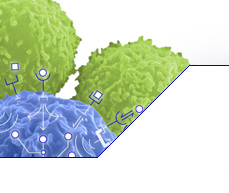Research Directions
What our lab really likes to do is build models of cellular processes, and use these models to predict and discover new biology. Under this general umbrella of 'model-driven discovery', we have three main interests:
Mapping out the Innate Immune System in Single Cells
We use live, single-cell imaging together with system modeling to study the activation of proteins such as NF-κB, a key transcription factor family involved in the immune response. The video below shows two cells, each expressing near-endogenous levels of an NF-κB subunit, called p65, fused to either a red or green fluorescent protein. When NF-κB is activated, it localizes to the cell nucleus and we can detect and quantify this by tracking the fluorescence. The two cells at below are different colors to enable us to watch a paracrine signal being passed from one cell to the other. The red cell is activated by the first signal, and then secretes a signal of its own, which is detected by the green cell. This turned out to be a critical piece of evidence in our recent study published in Science Signaling.
Host-Virus Interactions
Viral infections present a deadly paradox: in spite of the apparent simplicity of the viral genome, the complexity of the infection process has for the most part thwarted our attempts to prevent or cure it. One resolution of this paradox is that the complexity of infection is not limited by the scope of the viral genome, but by the host machinery that the virus must commandeer in order to replicate-in a sense, the victim is also an accomplice. Today, the best-characterized model of viral infection remains bacteriophage λ and its host-Escherichia coli. We recently identified the non-essential E. coli genes required for λ infection, and the results had some interesting surprises!
Building the World's First Whole-Cell Model
Our lab is currently working on a computer model of Mycoplasma genitalium which takes every gene into account. Our model will track all biological processes, including for example DNA replication, RNA transcription and regulation, protein synthesis, metabolism and cell division. Although until now different biological processes have been almost exclusively studied in isolation, they are in fact deeply and inseparably integrated. This whole-cell model will therefore enable us to pursue critically important questions which have never been addressed before.
Publications
- Karr JR, Sanghvi JC, Macklin DN, Gutschow MV, Jacobs JM, Bolival B, Assad-Garcia N, Glass JI, Covert MW. A Whole-Cell Computational Model Predicts Phenotype from Genotype. Cell 150, 389-401 (2012).
html | pdf
Links

